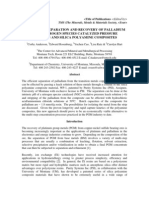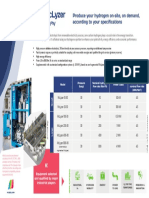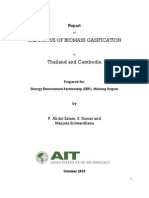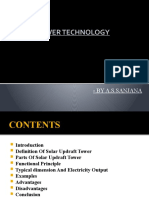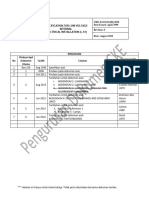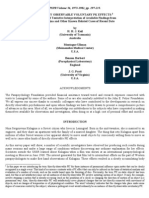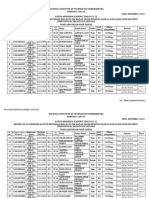0 ratings0% found this document useful (0 votes)
78 viewsNuclear Fusion
Nuclear Fusion
Uploaded by
Anonymous tr9QSvTdThis was my grade 7 One World Essay for Science (bad grammar sorry :p), since the curriculum of my school is IB. I chose nuclear fusion since everyone else chose relatively simple energy sources such as oil, wind, solar, etc.
Nuclear fusion is a nuclear reaction of fusing low atomic number atomic nuclei to form a much heavier nucleus, releasing energy that can be harnessed for electricity.
Copyright:
© All Rights Reserved
Available Formats
Download as DOCX, PDF, TXT or read online from Scribd
Nuclear Fusion
Nuclear Fusion
Uploaded by
Anonymous tr9QSvTd0 ratings0% found this document useful (0 votes)
78 views5 pagesThis was my grade 7 One World Essay for Science (bad grammar sorry :p), since the curriculum of my school is IB. I chose nuclear fusion since everyone else chose relatively simple energy sources such as oil, wind, solar, etc.
Nuclear fusion is a nuclear reaction of fusing low atomic number atomic nuclei to form a much heavier nucleus, releasing energy that can be harnessed for electricity.
Copyright
© © All Rights Reserved
Available Formats
DOCX, PDF, TXT or read online from Scribd
Share this document
Did you find this document useful?
Is this content inappropriate?
This was my grade 7 One World Essay for Science (bad grammar sorry :p), since the curriculum of my school is IB. I chose nuclear fusion since everyone else chose relatively simple energy sources such as oil, wind, solar, etc.
Nuclear fusion is a nuclear reaction of fusing low atomic number atomic nuclei to form a much heavier nucleus, releasing energy that can be harnessed for electricity.
Copyright:
© All Rights Reserved
Available Formats
Download as DOCX, PDF, TXT or read online from Scribd
Download as docx, pdf, or txt
0 ratings0% found this document useful (0 votes)
78 views5 pagesNuclear Fusion
Nuclear Fusion
Uploaded by
Anonymous tr9QSvTdThis was my grade 7 One World Essay for Science (bad grammar sorry :p), since the curriculum of my school is IB. I chose nuclear fusion since everyone else chose relatively simple energy sources such as oil, wind, solar, etc.
Nuclear fusion is a nuclear reaction of fusing low atomic number atomic nuclei to form a much heavier nucleus, releasing energy that can be harnessed for electricity.
Copyright:
© All Rights Reserved
Available Formats
Download as DOCX, PDF, TXT or read online from Scribd
Download as docx, pdf, or txt
You are on page 1of 5
Muhammad Irfan Muzhaffar Darmawan
7B
Mr. Arvi
Science
MATTER and ENERGY
Suitable Source of Energy
Nuclear fusion: A solution for
energy crisis
The problem is that the world needs more energy, as nonrenewables are rapidly declining today. We need to find another
source of renewable energy that would help energy crisis later on.
This problem is important to be solved since it affects the future of
the world. If its not solved, the world can have blackout, no energy.
Oil and Natural Gas are slowly decreasing since its a non-renewable
energy for a short time (that means its renewable in millions of
years, that cant cope with the energy needs of the world today).
The advantages of solving this problem are unlimited source of
energy, solving energy crisis that happens throughout the world,
and many more. But the limitations are if the energy damages the
environment (like hydroelectric dams block fishes migration, that is
important for increasing population), still uses some non-renewable
source (like solar panels), so here the student finds what is the best
solution for renewable energy.
The student thinks that Nuclear Fusion is the most suitable
energy source in the future because it can create an almost
unlimited energy for the world; it is like bringing sun to the earth by
technology. Nuclear fusion is the process of two or more atomic
nuclei collide at a very high speed. The process of converting the
matter into photons makes the photons (energy). This process is the
same as how the sun creates light and heat. It is also the opposite
of the process of Nuclear Fission, since fission separates atoms
while fusion combines (collide) atoms, and fission uses heavier
elements like Uranium while fusion uses lighter elements like Iron.
The process happens by many ways. For example:
The deuterium-tritium fusion, by that process it creates
helium-4, freeing a neutron and releasing 17.59 MeV of energy.
The advantage is high-energy neutron released. The
disadvantage is the tritium is because bombarding Lithium, with
neutrons makes radioactive waste and here scientists all over the
world are finding a way to use a really safe energy makes it. Theres
still a better way then deuterium-tritium fusion.
The deuterium-deuterium fusion, by that it creates a helium-3,
freeing a neutron, releasing 4.03 MeV of energy.
The advantage is it doesnt use tritium, which its process of
making creates radioactive waste when bombarding Lithium, so its
nuclear-free. The disadvantage is the energy released is not all in
the form of high-energy neutron, so the energy is much more less
than deuterium-tritium fusion.
So the advantages of nuclear fusion are an almost unlimited
energy, since deuterium from one cubic kilometer of seawater is
almost equal to the supply of the entire worlds oil reserves before
mined. It uses a reaction that doesnt make radioactive waste, like
fission. Fusion is just colliding, not like fission that is separating that
makes radioactive waste. We use the energy by using solar panels
(photovoltaic cells recommended) to capture the photons.
But, the disadvantages for now are the way to hold that much
heat, 100 million Kelvin. There isnt any substance can hold that
much heat, but there is a complex way to make it safe and
scientists are still finding a way to produce heat from nuclear fusion.
Good news is that at the National Ignition Facility at
Livermore, California, a really huge milestone is reached. US finally
succeeded to harness nuclear fusion. The hottest 192 laser beams
there was shoot to the holes at a target container called a
hohlraum. The hohlraum is a tiny pellet that contains an extremely
cold, solid mixture of hydrogen isotopes. The deadline, 30
September 2013, was passed with a hard work already worked for
more than a half century. But there was an unexpected technical
problem, which made the fusion output less than originally
predicted by mathematical models.
Any other way harnessing Nuclear Fusion is by doing the
fusion at outer space. The energy is captured by solar cells that are
going to be transmitted by electromagnetic waves to earth. The
advantage is that the explosion wont affect the Earth; people can
use tritium since the radioactive waste will float at the space. The
disadvantages are solar cell damage to too hot heat from the
photon, the solar cell or the fusion reactor being hit by an asteroid,
and any interference to the electromagnetic waves as also to the
photon capturing to the solar cells. People can also do this at a
lower pressure so the reaction can happen at a lower temperature
below 100 million Kelvin, but still its impossible since people can go
beyond the atmosphere to reach a really lower pressure to achieve
even 50 million Kelvin.
The process of energy transformation here is nuclear energy
to heat energy to electrical energy. But if we are using tritiumdeuterium fusion, the transformation is nuclear energy to nuclear
energy to heat energy to electrical energy (since the bombarding of
lithium makes radioactive waste that contains energy too). The
unwanted form of energy is light energy, because the explosion that
happened because of the fusion creates heat and light, while the
heat is used for the energy.
This energy, if can be harnessed, is really useful for the future
since the resources/fuels are still abundant, like deuterium and its
renewable since water is renewable; hydrogen is estimated 150
billion years of continuous consumption. Even if there isnt any
more hydrogen on earth (impossible since water is made of
hydrogen), an astronomer may mine deuterium directly from sun if
there is a technology, a suit that can withstand million degrees
Celsius (still impossible for now).
A prediction to economical effect is the trading of deuterium
that escalates when nuclear fusion is found. There will be many
companies trying to mine deuterium from sea, including naval
countries like Indonesia, Philippines, Thailand, Malaysia, the Oceania
continent islands (Fiji, Tonga, Palau, Polynesia, etc.), etc. and they
will mine the highest number and trying to sell those expensively.
So, nuclear fusion is the perfect solution since it doesnt
create any waste damaging to the environment. To overcome the
disadvantages we need to avoid the unexpected technical
difficulties of the lasers, which were depended on the success of the
first fusion process in the world. I recommend deuterium-deuterium
fusion since bombarding the Lithium, that makes radioactive waste,
makes tritium and quickly harness the nuclear fusion energy even
after first attempt for real usage.
Bibliography
Sample, Ian. "California Fires up Laser Fusion Machine." The
Guardian. The Guardian, 28 May 2009. Web. 23 Sept. 2013.
Hickman, Leo. "Fusion Power: Is It Getting Any Closer?" The
Guardian. The Guardian, 23 Aug. 2011. Web. 23 Sept. 2013.
Fraudenrich, Craig, Ph.D. "How Nuclear Fusion Reactors Work."
HowStuffWorks. HowStuffWorks, 12 Mar. 2011. Web. 08 Oct.
2013.
"Nuclear Fusion." Wikipedia. Ed. Electric Wombat. Wikimedia
Foundation, 10 Aug. 2013. Web. 08 Oct. 2013.
"Photon." Wikipedia. Ed. Vsmith. Wikimedia Foundation, 10
June 2013. Web. 08 Oct. 2013.
Rincon, Paul. "Nuclear Fusion Milestone Passed at US Lab."
BBC News. BBC, 10 July 2013. Web. 10 Oct. 2013.
"List of Oceanian Countries by Population." Wikipedia. Ed.
Funandtrvl. Wikimedia Foundation, 7 Oct. 2013. Web. 10 Oct.
2013.
"Welcome to Culham Centre for Fusion Energy, the UK's
National Fusion Research Laboratory." Fusion: Fusion. United
Kingdom Atomic Energy Authority, n.d. Web. 10 Oct. 2013.
You might also like
- NTU FYP PresentationDocument46 pagesNTU FYP PresentationchingkeatNo ratings yet
- Prediction of The Dew PointDocument9 pagesPrediction of The Dew PointBaptiste RéaudNo ratings yet
- Single Step Separation and Recovery of Palladium Using Nitrogen Species Catalyzed Pressure Leaching and Silica Polyamine CompositesDocument12 pagesSingle Step Separation and Recovery of Palladium Using Nitrogen Species Catalyzed Pressure Leaching and Silica Polyamine Compositesarissa2009No ratings yet
- NAMRIAs Role For Safer Navigation in The Philippines - 3Document53 pagesNAMRIAs Role For Safer Navigation in The Philippines - 3Cart Luma-angNo ratings yet
- Stone Plate Compactor Operator's Manual EnglishDocument50 pagesStone Plate Compactor Operator's Manual Englishornel jacksonNo ratings yet
- Cogeneration Fuel Cell-Sorption Air Conditioning SystemsDocument170 pagesCogeneration Fuel Cell-Sorption Air Conditioning SystemsAnonymous gg2Mi4No ratings yet
- Bagasse HP Boiler Cogeneration EconomicDocument3 pagesBagasse HP Boiler Cogeneration Economicjeanpaul CAYTANNo ratings yet
- Is 5082 1998Document11 pagesIs 5082 1998dipenkhandhediyaNo ratings yet
- The Interdependence Between The Major Sectors, MarketsDocument13 pagesThe Interdependence Between The Major Sectors, Marketskashalala100% (1)
- Hydrogenics - Power-To-GasDocument19 pagesHydrogenics - Power-To-GasGreenEnergyFuturesNo ratings yet
- Fundamentos ElectroquimicaDocument1 pageFundamentos ElectroquimicaCristian Leonardo Burgos SuescunNo ratings yet
- My Proposal 1Document16 pagesMy Proposal 1Rahi FurqanNo ratings yet
- 2012 Appendix C: Hydrogen QualityDocument3 pages2012 Appendix C: Hydrogen QualityMabrur ZanataNo ratings yet
- 20.05.McPhy Portfolio ELY McLyzer enDocument1 page20.05.McPhy Portfolio ELY McLyzer enamsukdNo ratings yet
- Itm - Hgas3sp PemDocument1 pageItm - Hgas3sp PemLukas MarconNo ratings yet
- Solar Cells Technology 2Document38 pagesSolar Cells Technology 2fahimmahmudNo ratings yet
- The Hydrogen Energy Transition (2004) Daniel SperlingDocument261 pagesThe Hydrogen Energy Transition (2004) Daniel SperlingmirzafarhathNo ratings yet
- Electrochemical Energy Storage For Green Grid PDFDocument37 pagesElectrochemical Energy Storage For Green Grid PDFpokygangNo ratings yet
- Software Implementation of The Duval TriangleDocument5 pagesSoftware Implementation of The Duval TriangleMohammed MushtahaNo ratings yet
- Hitec Solar SaltDocument3 pagesHitec Solar Saltlmf_pachecoNo ratings yet
- The Status of Biomass Gasification in Thailand and CambodiaDocument103 pagesThe Status of Biomass Gasification in Thailand and CambodiacjoyeuxNo ratings yet
- Applied EnergyDocument28 pagesApplied EnergyGaneshNo ratings yet
- Hydrogen The Fuel For 21st Century PDFDocument12 pagesHydrogen The Fuel For 21st Century PDFAlex CoțNo ratings yet
- Decarbonize The Natural GasDocument4 pagesDecarbonize The Natural GasGabriel ColmontNo ratings yet
- D3.1 - International Curriculum On Hydrogen Safety Training For First Responders - V7.0Document61 pagesD3.1 - International Curriculum On Hydrogen Safety Training For First Responders - V7.0luke hainesNo ratings yet
- Advances in Alkaline Water Electrolyzers: A Review: A, B, C, C A, BDocument54 pagesAdvances in Alkaline Water Electrolyzers: A Review: A, B, C, C A, BJoshua Mitchell100% (1)
- Steps Toward The Hydrogen Economy: S.S. PennerDocument11 pagesSteps Toward The Hydrogen Economy: S.S. PennerAbdallah MostafaNo ratings yet
- Pressure Retarded Osmosis (PRO)Document8 pagesPressure Retarded Osmosis (PRO)vitileeNo ratings yet
- Scotland h2 Gov IncentiveDocument44 pagesScotland h2 Gov IncentiveIan PillayNo ratings yet
- 7171 Oxyfuel Combustion For Below Zero CO2 EmissionsDocument462 pages7171 Oxyfuel Combustion For Below Zero CO2 EmissionsJoão13@No ratings yet
- Research Papers On Hydrogen Fuel CellsDocument7 pagesResearch Papers On Hydrogen Fuel Cellsfvey0xan100% (1)
- Hydrogen: The "Forever Fuel" That We Can Never Run Out ofDocument26 pagesHydrogen: The "Forever Fuel" That We Can Never Run Out ofSunil AroraNo ratings yet
- Solar Tower TechnologyDocument29 pagesSolar Tower Technologysanjana16dec100% (2)
- Modelling of Claus Sulfur Recovery UnitDocument5 pagesModelling of Claus Sulfur Recovery UnitTifano KhristiyantoNo ratings yet
- Advances in Ethanol ReformingDocument9 pagesAdvances in Ethanol ReformingDhrupad ParikhNo ratings yet
- Hidrogeno Revision PDFDocument6 pagesHidrogeno Revision PDFtunja1No ratings yet
- Experiment 4 Dynamic Response of Temperature Measuring Devices (Transient Heat Transfer)Document6 pagesExperiment 4 Dynamic Response of Temperature Measuring Devices (Transient Heat Transfer)praful2604No ratings yet
- PEM Fuel Cell PDFDocument16 pagesPEM Fuel Cell PDFEldhose Shaju100% (1)
- Research in Electric GenerationDocument35 pagesResearch in Electric GenerationlightrocketNo ratings yet
- Modelling and Simulation of Hybrid Micro Grid Employing DG, PV, Wind and Fuel CellDocument7 pagesModelling and Simulation of Hybrid Micro Grid Employing DG, PV, Wind and Fuel Cellرافع العرفيNo ratings yet
- Enotec2 PDFDocument6 pagesEnotec2 PDFamk2009No ratings yet
- 1998-Plasma Reforming of MethaneDocument8 pages1998-Plasma Reforming of MethaneakkusawNo ratings yet
- Green Hydrogen PPT ExcerptsDocument2 pagesGreen Hydrogen PPT ExcerptsMohammad AtaullahNo ratings yet
- Tidal EnergyDocument39 pagesTidal EnergyNasim MammadovNo ratings yet
- 11.2 MW, Indirect Air Economizer, 10875m: Design OverviewDocument10 pages11.2 MW, Indirect Air Economizer, 10875m: Design Overviewahmadgce04No ratings yet
- 13.MCB For Motor ProtectionDocument48 pages13.MCB For Motor Protectionrajinipre-1No ratings yet
- 8.1 Energy SourcesDocument42 pages8.1 Energy SourcesLuis BenavidesNo ratings yet
- Clean Coal Technologies For Power GenerationDocument315 pagesClean Coal Technologies For Power GenerationAaditya Pratap Sanyal100% (1)
- Biomass HandbookDocument17 pagesBiomass HandbookSIVA100% (1)
- Rase 2000Document135 pagesRase 2000Valentin RadulescuNo ratings yet
- Iec 60811 501 2012Document12 pagesIec 60811 501 2012researchmaterial78690No ratings yet
- PDF Battles of DograiDocument61 pagesPDF Battles of DograiSurya TiwariNo ratings yet
- Hydrogen Bonding-New InsightsDocument535 pagesHydrogen Bonding-New InsightsOmar Alejandro SalazarNo ratings yet
- Study of Some Electrolysis Parameters For Chlorine and Hydrogen Production Using A New Membrane ElectrolyzerDocument8 pagesStudy of Some Electrolysis Parameters For Chlorine and Hydrogen Production Using A New Membrane ElectrolyzerRaghul T100% (1)
- Top 2018-03-02 FC Expo Nel FinalDocument37 pagesTop 2018-03-02 FC Expo Nel Finalmsantosu000No ratings yet
- Applications of Proton Exchange Membrane Fuel CellDocument20 pagesApplications of Proton Exchange Membrane Fuel CellRiri SasyNo ratings yet
- TASK - Hydrogen Fuel CellDocument3 pagesTASK - Hydrogen Fuel CellElse Feba PaulNo ratings yet
- Nuclear PowerDocument9 pagesNuclear PowerHayamMahmoud-AhmedNo ratings yet
- Fusion Energy and The Future: Tsang 1Document7 pagesFusion Energy and The Future: Tsang 1Ryfb StanfordNo ratings yet
- Power to the People: The Greatest Transition of Wealth in American HistoryFrom EverandPower to the People: The Greatest Transition of Wealth in American HistoryNo ratings yet
- Seattle Pump and Equipment CatalogDocument195 pagesSeattle Pump and Equipment CatalogXavier PincayNo ratings yet
- Effects of Trade Openness On Regional Economic GrowthDocument5 pagesEffects of Trade Openness On Regional Economic GrowthMOHD NOR HIDAYAT MELBINNo ratings yet
- Last Hope: Paul VerlaineDocument9 pagesLast Hope: Paul VerlaineMadisonFosterNo ratings yet
- Modbus Ethernet ManualDocument52 pagesModbus Ethernet ManualCarlos MercadoNo ratings yet
- Character Profile WorksheetDocument5 pagesCharacter Profile Worksheetapi-395615839No ratings yet
- Avoir in French Conjugation, Tenses & ExamplesDocument1 pageAvoir in French Conjugation, Tenses & Examplesgracebon26No ratings yet
- HSBC Technology - Trainee Software EngineerDocument2 pagesHSBC Technology - Trainee Software EngineerHarshNo ratings yet
- Thesis: Study of Slang Word in "Ride Along" MovieDocument58 pagesThesis: Study of Slang Word in "Ride Along" MovieDen KellyNo ratings yet
- Bda X7Document51 pagesBda X7Felix EstrellaNo ratings yet
- Artículo MUY ImportanteDocument19 pagesArtículo MUY Importantekarol lassoNo ratings yet
- L-s1 Specification For Low Voltage Internal Electrical InstallationDocument154 pagesL-s1 Specification For Low Voltage Internal Electrical InstallationKNS CSBNo ratings yet
- Centralized Organizations: Advantages of Decentralized ManagementDocument9 pagesCentralized Organizations: Advantages of Decentralized ManagementMaritess MunozNo ratings yet
- An Overview of Family DevelopmentDocument18 pagesAn Overview of Family DevelopmentMiyangNo ratings yet
- Measures of Central Tendency and VariabilityDocument38 pagesMeasures of Central Tendency and Variabilityapi-619738021No ratings yet
- Nina Kulagina PSPR Volume 56Document22 pagesNina Kulagina PSPR Volume 56Fabiano GummoNo ratings yet
- Benefits For The Buying Company: 1. Vendor Managed Inventory (Vmi)Document10 pagesBenefits For The Buying Company: 1. Vendor Managed Inventory (Vmi)raish alamNo ratings yet
- S3C9442/C9444/F9444/C9452/C9454/F9454 Sam88Rcri Instruction SetDocument50 pagesS3C9442/C9444/F9444/C9452/C9454/F9454 Sam88Rcri Instruction SetThanhha NguyenNo ratings yet
- The European Journal of Applied Economics - Vol. 16 #2Document180 pagesThe European Journal of Applied Economics - Vol. 16 #2Aleksandar MihajlovićNo ratings yet
- LIT 1 - BIBLE STORIES - Escobar, Kaye M.Document11 pagesLIT 1 - BIBLE STORIES - Escobar, Kaye M.KAYE ESCOBARNo ratings yet
- Fungsi MNJ Pengawasan Mutu 2022Document56 pagesFungsi MNJ Pengawasan Mutu 2022patricia ngeraNo ratings yet
- The Waste LandDocument5 pagesThe Waste Landarianna beniniNo ratings yet
- National Institute of Technology Kurukshetra HARYANA-136119: B.Tech Admission Academic Year-2021-22Document93 pagesNational Institute of Technology Kurukshetra HARYANA-136119: B.Tech Admission Academic Year-2021-22Arjun RamavathNo ratings yet
- Gok-md050.Xxx Po Approval WFDocument8 pagesGok-md050.Xxx Po Approval WFnagarajuvcc123No ratings yet
- Cambridge IGCSE: CHEMISTRY 0620/42Document12 pagesCambridge IGCSE: CHEMISTRY 0620/42Manya PunjabiNo ratings yet
- Examen Anglais 2008 Session Rattrapage Sujet 5Document3 pagesExamen Anglais 2008 Session Rattrapage Sujet 5simo tahiriNo ratings yet
- Riegler Pneumatikspeicher Sicherheitsventil GBDocument10 pagesRiegler Pneumatikspeicher Sicherheitsventil GBGyörgy MurvaiNo ratings yet
- Raub Oil MillDocument7 pagesRaub Oil Millnaavin muthu krishnanNo ratings yet
- Mirth Data Sheet Mirth Connect 3 5 User GuideDocument350 pagesMirth Data Sheet Mirth Connect 3 5 User GuidelevilevideejayNo ratings yet


